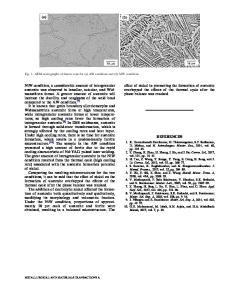Investigation of microstructure, mechanical, and corrosion behavior of nickel-based alloy 625/duplex stainless steel UNS
- PDF / 11,337,035 Bytes
- 12 Pages / 595.276 x 790.866 pts Page_size
- 64 Downloads / 357 Views
RESEARCH PAPER
Investigation of microstructure, mechanical, and corrosion behavior of nickel-based alloy 625/duplex stainless steel UNS S32205 dissimilar weldments using ERNiCrMo-3 filler metal M. Tümer 1 & T. Mert 2 & Tuba Karahan 3 Received: 2 April 2020 / Accepted: 9 October 2020 # International Institute of Welding 2020
Abstract In this study, nickel-based alloy 625 and duplex stainless steel (DSS) UNS S32205 (2205) dissimilar pairs were welded with metal inert gas (MIG) welding process. Weld metal, obtained with the utilization of ERNiCrMo-3 filler wire, was subjected to mechanical, microstructural, and corrosion investigations. V-notch impact tests and micro hardness measurements were realized on dissimilar weld metal. Microstructural changes in weld metal, fusion line, and heat-affected zone were examined using optical, scanning (SEM), and transmission electron microscopes (TEM) with energy-dispersive spectrometry (EDS). Phase precipitations rich of Nb and Mo were detected among dendritic austenite arms in the weld metal. It was observed that ERNiCrMo-3 filler metal had sufficient toughness because of high nickel content. Corrosion tests revealed that weld metal face pass is the least corrosionresistant zone in weld metal unlike weld root. This is mainly because more intense intermetallics formed in weld metal face compared with the middle of the weld and the root. Keywords Nickel alloy . Duplex stainless steel . MIG welding . ERNiCrMo-3 wire . Microstructural characterization . Corrosion
1 Introduction Dissimilar joining of nickel-based super alloys and stainless steels are widely used in oil refinery steam generators, chemical tankers, pressure vessels, pipes of heat exchangers, and petrochemical and nuclear energy plants [1, 2]. The most important characteristics of these alloys are their high corrosion resistance in aggressive environment and the ability to fulfill strength requirements at the same time [3–5]. The application Recommended for publication by Commission II - Arc Welding and Filler Metals * Tuba Karahan [email protected] M. Tümer [email protected] T. Mert [email protected] 1
Kocaeli University, 41180 Kartepe/Kocaeli, Turkey
2
Yıldız Technical University, 34349 Beşiktaş/İstanbul, Turkey
3
İstanbul Gedik University, 34876 Kartal/İstanbul, Turkey
areas of dissimilar joining of Ni-based super alloys and duplex stainless steels are maritime and chemical industry and, in addition, geothermal industry because of their ease of joining, good corrosion resistance, and high strength [6]. Ni-based super alloy loses 1/3 of its yield strength when temperature rises to 485 °C, compared with its strength at 100 °C. Yet, it retains this strength until 820 °C and, even at 700 °C, an increase in strength can be observed and the decrease in yield strength compared with 100 °C would be limited to 25% [7]. Alloy 625, is a nickel-based solid solution-strengthened super alloy, which is widely used in applications that require high corrosion resistance. Austenite microstructure is reinf
Data Loading...











